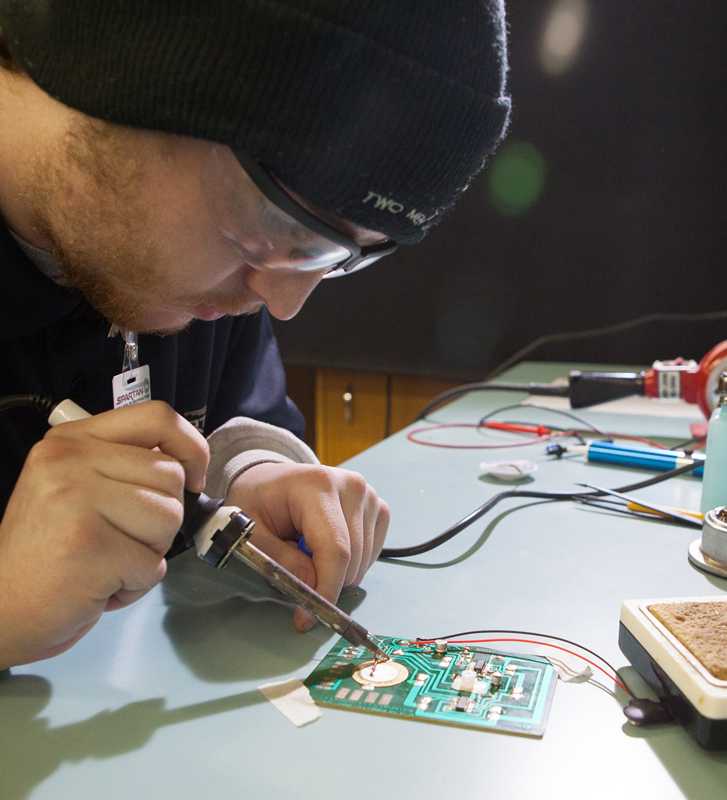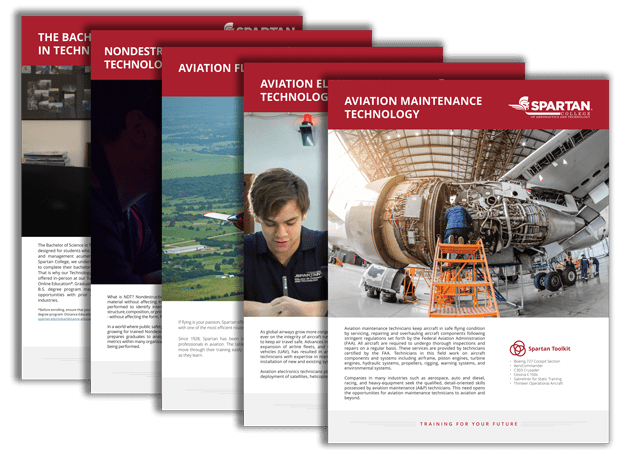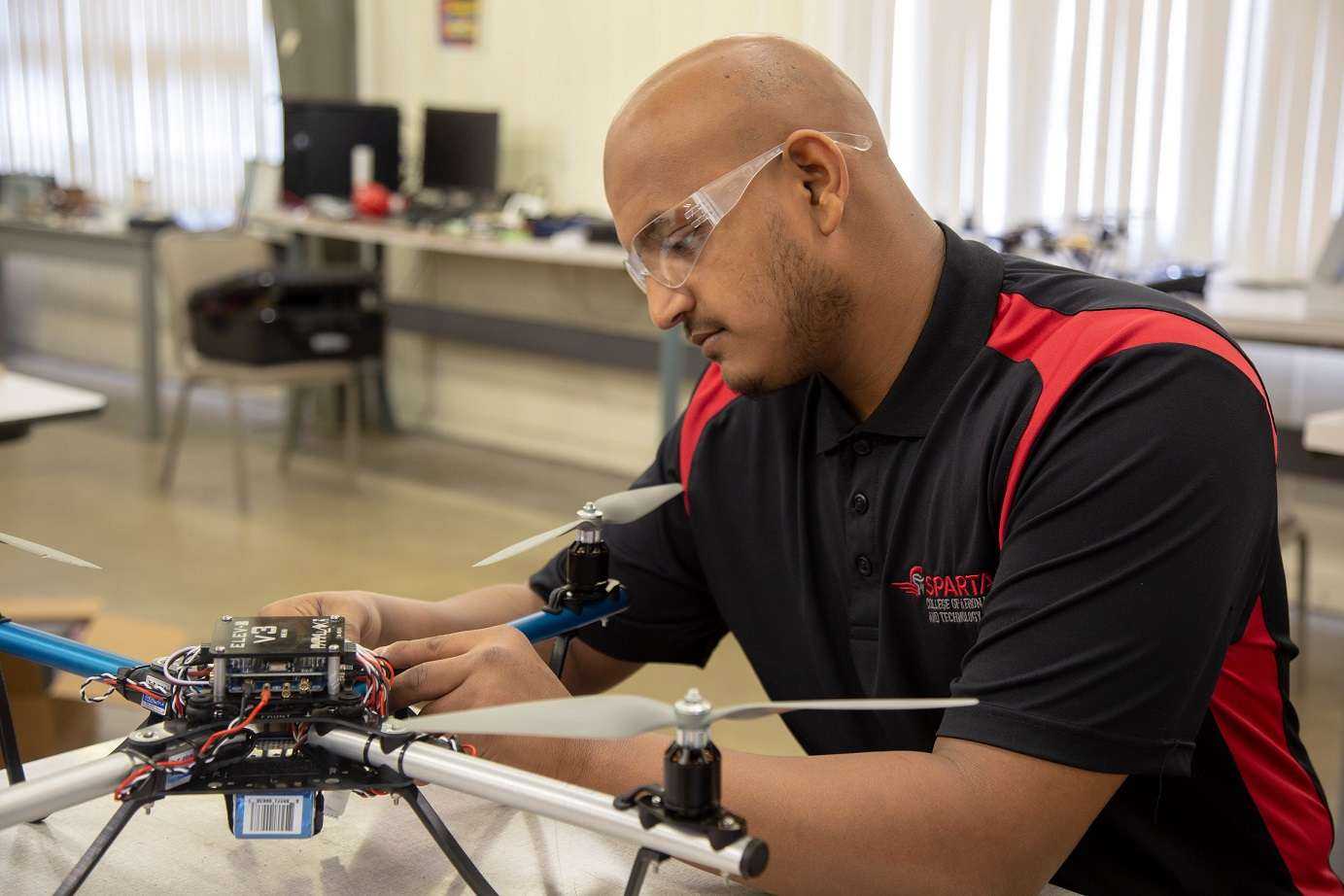Aviation Electronics Technology In Denver Area

Training the Next Generation of Aviation Electronics Technicians
Spartan’s Aviation Electronics Technology (AET) program has been training Electronics Systems Technicians for decades. Our students train to use industry-related technology to test the reliability and operational status of Avionics Systems. In addition, students build their own electronic trainer, FM receiver, and more; including assembling and programming their own Drone (Unmanned Aerial Vehicle).
Interested in Learning More?

Program Details
Associate of Applied Science in Aviation Electronics Technology
(Degree) · Program Length: 15 months
Through the use of industry-relevant training devices and curriculum developed for unmanned aerial vehicle (UAV) electronics and aircraft technicians, students may learn technical skills for today’s advanced electronics and aerospace industries. Students study FAA regulations, learn to read and use aircraft maintenance manuals, how to read and interpret aircraft commercial drawings and electronics schematics as they apply to large and small aircraft including UAVs. In addition, associate degree students focus on interpersonal skills such as oral and written communication, customer service, and diversity in the workplace.
Total Credit Hours: 68
Total Months: 15
Certification Disclosure Information - FCC
Certification Disclosure Information - FAA

PREPARE FOR TAKEOFF BY GETTING A LAY OF THE LAND
Course Work

Part of the Demand for Airline Technicians
according to the Boeing Pilot Technician Outlook 2021 – 2040.
*Boeing: Pilot and Technician Outlook, http://www.boeing.com/commercial/market/pilot-technician-outlook/
WHAT EQUIPMENT DOES OUR SCHOOL HAVE TO OFFER?
NEARLY 8,000 SQ. FT. OF CLASSROOM AND LAB SPACE
NEARLY 8,000 SQ. FT. OF CLASSROOM AND LAB SPACE
CUSTOM AUTOPILOT TRAINERS
CUSTOM AUTOPILOT TRAINERS
GARMIN 1000 TRAINING KIOSKS
GARMIN 1000 TRAINING KIOSKS
WIDE RANGE OF TEST BENCHES
WIDE RANGE OF TEST BENCHES
RIGOL SPECTRUM ANALYZERS
RIGOL SPECTRUM ANALYZERS
Sample Classes
This course is a complete study of electronic communication theory, with a focus on aircraft communications. Students will study AM and FM modulation, transmitters, and receivers. These knowledge areas are then applied to avionics specifically as the students learn about HF com, VHF com, and satellite communications/in-flight entertainment systems.
This course is a study of aviation navigation systems and their instrumentation. The nav systems studied include VOR, GPS, Localizer, Glide Slope, Marker Beacon, and Gyros. Channeling methods and aviation-specific data busses are also introduced. This course also goes into various analog instruments and how different systems are displayed on the flight deck.
In this course, students will learn many of the aspects of Unmanned Aerial Systems (UAS), including classes, size, capabilities/limitations and different technologies, and different Robotic technologies as well as the FAA regulations associated with UAS’s.
Industry Outlook
- Production responsibilities include:
- Configure the Range for RF operation.
- Utilize overhead cranes to move heavy / large tooling and equipment.
- Install and assemble defined Range test tooling.
- Set-up and calibrate the Range for test execution per documented procedure, specification or standard.
- Install and connect antennas to be tested.
- Execute RF tests per documented procedure.
- Process and plot required Range data files as defined.
- Sign-off on test operations certifying that tests have been conducted as specified in the product acceptance test procedure.
- Utilize paper or electronic formats to maintain required process logs, records and reports in accordance with BATC policies and government regulation.
- Use internal electronic scheduling system to tear-down and set-up for the next scheduled test.
- Initiate emergency procedures in case of power failure; recognize safety hazards, including hazardous materials, and pursue corrective action when necessary.
- Initiate and sustain process improvement activities to increase process efficiency and reduce risks to hardware or data quality.
- Execute equipment and system maintenance activities.
- Support prototype / development RF testing.
- Set-up of Range and execution of special tests with minimal engineering oversight, direction or documentation.
- Conduct tests; monitor, analyze, reduce and record data; and perform mathematical calculations.
- Will also be expected to support the Range in a more operational role, including performance of preventive maintenance and some Range maintenance tasks.
- May be required to read / document schematic diagrams.
- Troubleshoot circuits to the component level.
- Assemble electronic circuits and perform cause and affect analysis.
- Avionics installations and repairs on general aviation aircraft. Garmin, Honeywell and other manufacturers aircraft installations and wire harnessing.
- Professional trouble shooting expertise with glass cockpits and across the whole aircraft avionics spectrum.
- Install, inspect, test, adjust, or repair avionics equipment, such as radar, radio, navigation, and missile control systems in aircraft or space vehicles.
- Test and troubleshoot instruments, components, and assemblies, using circuit testers, oscilloscopes, or voltmeters.
- Keep records of maintenance and repair work.
- Adjust, repair, or replace malfunctioning components or assemblies, using hand tools or soldering irons.
- Performs inspection, testing, troubleshooting, repairing, removal and replacement of aircraft instrument and avionics components and systems using various hand tools and test equipment to meet manufacturer’s specifications, FAR’s, industry standards approved procedures in a safe and organized work area.
- Complete installation of aircraft options and modifications. Mark wires, assemble, and terminate using crimp and solder techniques and test wire harness to engineering drawings.
- Perform pitot/static system modification and testing including FAR 91.411 and 91.413 certification.
- Adhere to company procedures, FAA, and FOCA regulations and guidelines.
- Perform general avionics support items on aircraft.
- This shall include, but not be limited to items such as removal and installation of panels and components and repair work.
- Troubleshooting and evaluation of systems on the aircraft when designated. Inspection and evaluation of the aircraft and components when designated. Maintenance and repair of shop facility, equipment and tooling to support operations.
- Modifying incomplete and complete assemblies and incorporating the changes into the structure, monitoring and verifying quality in accordance with statistical process or other control procedures, and performing various maintenance duties.
- Conduct calibration work at customer on-sites with little to no direction.
- Identify and utilize appropriate measurement techniques.
- Understand and apply uncertainties to measurements made. Be able to read and interpret labs’ scopes of accreditation.
- Assists in installations, modifications and the fabrication of wiring and electrical components, fixtures, and associated equipment in accordance with blueprints, worksheets, engineering drawings
- Fabricate and/or install basic avionics and electrical systems
- Assist with more complex installation tasks
- Disassemble and reassemble aircraft interior as directed to facilitate avionics installation or repairs
- Complete light sheet metal fabrications as directed to facilitate avionics installation or repairs
- Assist with the completion of tasks within allotted time frame
- Assist with wiring harness maps or mock-ups
- Assist with maintaining required logs and records
- Complete wiring harness fabrication and installation
- Has general knowledge of applicable regulatory requirements and customer specifications
- Complete antenna installations
- Complete coax installations
- Complete or assist with OHM and power checks
- Complete or assist with ground checks
- Properly care for and maintain shop equipment and tools as assigned by Supervisor
- Performs other duties as assigned
- Test, troubleshoot (to component level), and repair digital and analog RF electronic systems.
- Test, troubleshoot (to component level), and debug hardware anomalies or acceptance test failures.
- Demonstrate familiarity and working knowledge of RF antennas and electronics.
- Review and correctly interpret schematics, drawings, specifications and procedures for complex electrical systems.
- Maintain required logs, records, databases, manuals, and reports in accordance with Quality Business System requirements.
- Plan and commit resources to assure task completion.
- Work in a team oriented atmosphere with assemblers, technicians and engineers completing tasks and communicating effectively, both verbally and in writing, within an RF production organization.
- Maintain a regular and predictable work schedule.
- Establish and maintain effective working relationships within the department, the Strategic Business Units, Strategic Support Units and the Company.
- Interact appropriately with others in order to maintain a positive and productive work environment.
- Perform other duties as necessary.
- Installs and maintains high-speed, industrial process equipment for can and/or end making, power, lighting, control, and PLC logic controls for all production process and control equipment.
- Complies with established job safety practices, policies and procedures as specified in plant and corporate directives for the safe performance of the work assignment.
- Troubleshoots, adjusts, and repairs all electrical equipment, components, transducers, and complex timing and inspection devices.
- Performs preventative maintenance on assigned electrical systems.
- Identifies inefficiencies and potential electrical problems and coordinates through supervisor to resolve.
- Diagnoses causes of malfunctions and corrects through programmable logic controls. Ensures efficient equipment operation through proper line control programming and proactively suggests methods to improve line performance.
- Installs and troubleshoots facility power distribution and lighting services.
- Conduct, coordinate, and facilitate the installation, maintenance, test, and repair of various electrical control panels and test cell equipment.
- Coordinate and schedule electrical panel and test cell production activities.
- Maintain inventory of necessary electrical supplies.
- Maintain compliance to applicable electrical safety codes.
- Conduct wiring and installation of electrical components and circuitry on vacuum pump systems.
- Inspects wiring and fixtures for conformance specifications using testing equipment.
- Plans and lays out jobs from blueprints and specifications for electrical and electrical systems.
- Conducts testing of electrical components and equipment.
- Coordinates installation of electrical components onto pump assemblies with production manager and other support departments.
- Overseeing safe operation of the engine test cell following a specified test plan.
- Working closely with engineering staff to assure engines are performing as requested during testing.
- Routine maintenance of the test cell and related equipment per documented procedures
- Removal and installation of engines in the test cell.
- Maintenance, troubleshooting and minor repairs to test engines.
- Calibration of test cell measurement equipment.
- Specification and ordering of parts from suppliers/catalogs and purchase through internal purchase requisition system.
- Diagnosing mechanical problems and determining how to correct them using equipment manuals, parts catalogs or drawings as necessary.
- Maintaining detailed electronic records and project documentation.
- Performing duties safely and efficiently with minimal supervision.
- Flexibility, initiative and the willingness to respond to shifting time and project demands.
- Installation of Copper cabling: Cat5E, Cat6, Cat6A / Fiber Optic Cabling.
- Multimode and single mode fiber optic cable /Access Control cabling / Audio Visual cabling / Security camera cabling / Copper and fiber patch cords and patching services / Indoor and outdoor wireless access points.
- OTDR testing, troubleshooting and repair for fiber optic cabling.
- TDR testing, troubleshooting and repair for copper cabling.
- Aerial installations.
- Underground installations.
- Fusion and Mechanical splicing.
- Test circuits and components of malfunctioning telecommunications equipment to isolate sources of malfunctions, using test meters, circuit diagrams, polarity probes, and other hand tools.
- Test repaired, newly installed, or updated equipment to ensure that it functions properly and conforms to specifications, using test equipment and observation.
- Assemble and install communication equipment such as data and telephone communication lines, wiring, switching equipment, wiring frames, power apparatus, computer systems, and networks.
- Run wires between components and to outside cable systems, connecting them to wires from telephone poles or underground cable accesses.
- Test connections to ensure that power supplies are adequate and that communications links function.
- Repair or replace faulty equipment such as defective and damaged telephones, wires, switching system components, and associated equipment.
- Remove and remake connections to change circuit layouts, following work orders or diagrams.
- Analyze test readings, computer printouts, and trouble reports to determine equipment repair needs and required repair methods.
- Adjust or modify equipment to enhance equipment performance or to respond to customer requests.
- Refer to manufacturers' manuals to obtain maintenance instructions pertaining to specific malfunctions.
- Route and connect cables and lines to switches, switchboard equipment, and distributing frames, using wire-wrap guns or soldering irons to connect wires to terminals.
- Operations include component lead forming/tinning, hand soldering, encapsulation, hardware installation and complex rework/repair as needed.
- Demonstrated competencies in the following: component prep (lead forming/tinning/packaging), hand soldering various surface mount and through hole components, performing complex PWA rework, repair, and ‘white wire’/’dead bug’ operations.
- Perform all assigned tasks based on demonstrated, certified skills, and abilities necessary to produce, assemble and validate both ground and flight electronic assemblies; including cables, harness, and printed circuit boards with exceptional attention to detail.
- Solder, bond and coating certification.
- Prior fabrication, cable and harness experience.
- Box / Module assembly experience. Previous industry related certifications to include: NASA Hand Solder, J-STD, Hardware Torquing, Adhesive Bonding, Polymerics, Connector Mate & De-mate, NASA Cable Harness.
- Works from established test procedures and may be required to follow general instructions to perform complex environmental and functional acceptance tests, including vibration, thermal cycling and thermal vacuum tests on satellite electrical and electronic components and sub-assemblies to ensure proper operation.
- Reads and interprets information displayed on such test equipment as oscilloscopes, data recorders, telemetering equipment, wiring analyzers and other specially designed electronic tools.
FAQ's
First, provide proof you have graduated high school or equivalent, like the General Education Development (GED) test. Have your high school send us your official transcript or provide a copy of the military DD214 that includes proof of your graduation.
For a full list of prerequisites, check out our College Catalog for our Denver-area programs.
They’re the same thing. Avionics is the shorter, catchier (and older) nickname for the profession and program. Avionics helps keep your conversation going without saying the mouthful that is Aviation Electronics Technology.
Great question, Spartans have gone to work in roles like:
- Avionics Technician
- Bench Technicians
- Biomedical Technician
- Aircraft Electronics Test Technician
- Assembly & Tester
- Avionics Installation Technician
- Field Avionics Technician
- Test Technician for radio communications
- Test, Repair, & Install Technician for the aerospace industry
- Avionics Line Technician
- Satellite Technician
- Cable Install Technician
- Drone Operator (repair, coding and flying)
Check out our updated Catalog Supplement guide. It’ll give you the full scoop on all tuition, fees, and any associated costs of training at Spartan. Get in touch to learn more.
Here is a small sampling of AET courses:
- Amplifiers and Power Control Devices
- Industrial Controls and Robotics
- Aerospace Soldering and Inspection
- Aerospace Wiring
- Avionics Communication Systems
- Navigation and Instrumentation
- Radar and Pulse Systems
- Unmanned Aerial Systems and Robotics
A day in the life of a typical AET student involves building and troubleshooting aviation and aerospace electronics, programming and flying drones, assembling and testing radar systems, using high reliability soldering and building wiring harnesses to integrate systems, and so much more. There’s hardly a dull day.
Yes. You’ll take courses like College Mathematics, College Physics, English Composition, American History: 1865 to Present, Public Speaking, and Modern Sociology.
Most students find our class times convenient to their busy lifestyles even though the campus operates on a set schedule.
Around half of your time as a student will be spent in class and the other in hands-on lab environment.
No.
Head over to see the aviation pioneers who have come before you on our Spartan Alumni and Denver-area testimonials pages!
You probably have a lot of questions about college. If you don’t find the answers you need on these pages, just call 303-410-2403 to speak with an admissions representative.